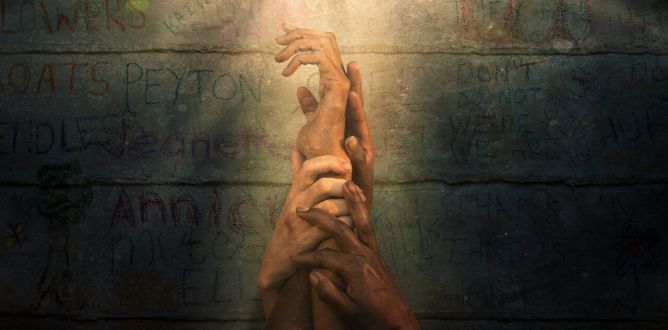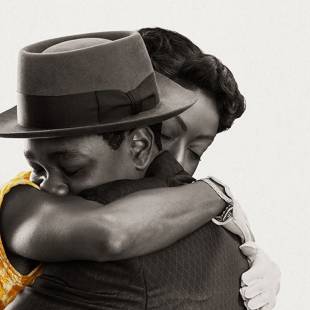Trees of Peace Parent Guide
What would you to do survive?
Parent Movie Review
In 1994, the central African state of Rwanda seized the world’s attention with a horrifying bloodbath. After the death of the Rwandan president was blamed on the Tutsi minority, the majority Hutu population sought revenge. Primed by years of inflammatory propaganda, large numbers of Hutus grabbed their machetes and began slaughtering their neighbors. Over the next 100 days, the killing spree would leave 800,000 dead.
Trees of Peace opens in the early days of the genocide. The principal character is Annick Irakoze, a thoughtful, gentle woman, married to Francois, a teacher. Both are Hutus, but they are moderates and want no part in the killings. Determined to save his pregnant wife and unborn son, Francois lowers her into the tiny cellar beneath their kitchen. In the next few days, he brings three more women: Jeanette, a nun; Peyton, an American volunteer teacher; and Mutesi, a young Tutsi woman who “claims her anger like her name”. As the days unfold, the women grapple with logistical challenges, recoil from the violence they hear through their tiny window, and learn to work through their differences, while forging an unbreakable bond.
Given the violent historical context, parents and teachers who are considering this film for teenagers will be understandably concerned about levels of negative content. Thankfully, the setting mitigates against a gore-fest. Almost the entire film is shot in the cellar – a cube so small that the women can’t stand up straight. Through their window, they witness people being raped and murdered and overhear gruesome conversations about torture and death. This can be disturbing, but, frankly, if a movie about genocide isn’t upsetting, the filmmakers have done something wrong. With Trees of Peace, director Alanna Brown depicts the horrors of Rwandan history and the individual trauma in the women’s lives in a way that is honest without being explicit or gruesome. It’s a real achievement and makes the movie accessible to a broader audience.
Along with its moving story, the script provides both relevant warnings and uplifting messages that will hit home for viewers of any age or culture. First, the warnings. As social media continues to make our politics ever more polarized and toxic, Rwanda stands as a cautionary tale. Having consumed hate-filled, ethnocentric radio and television broadcasts, the Hutu killers in the massacre repeatedly refer to Tutsis as “cockroaches”. Denying the humanity of others is a common tactic in extremist political discourse and Rwanda reminds us of how deadly dehumanizing and stereotyping others can become.
Despite the darkness, Trees of Peace also carries messages of hope, forgiveness, and the power of female friendships. The women struggle in their confined spaces as they figure out sanitation, share inadequate food, and deal with each other’s emotional challenges. None of the women are perfect but Annick’s gentle kindness provides a safe place as they all work through the burdens they carry. There are powerful moments as the women empathize with one another, stop judging, and help each other persevere through the grueling physical and emotional experiences they share.
Trees of Peace is a film that will leave you appalled at the horrors that humans can inflict on each other. It will also give you a sense of awe for the resilience and power of the women in the story. And, it will not surprise you to know that it is female leadership that provided much of the guidance Rwanda needed as it healed from its horrible history and continues to rebuild for a new generation.
Directed by Alanna Brown. Starring Eliane Umuhire, Charmaine Bingwa, Ella Cannon, and Bola Koleosho. Running time: 97 minutes. Theatrical release June 10, 2022. Updated January 13, 2024Watch the trailer for Trees of Peace
Trees of Peace
Rating & Content Info
Why is Trees of Peace rated TV-MA? Trees of Peace is rated TV-MA by the MPAA for language, suicide, and sexual violence.
Violence: People are heard screaming. Genocide is a theme of the movie. Dead bodies are seen frequently. Gun shots are heard repeatedly. People are shown being murdered with machetes. A man holds a machete to a teenager’s throat. A man forces a teenager to arm himself with a machete. There are bloodstains on a man’s clothes and weapon. Men threaten to kill a woman’s family. A woman is kicked by men. A woman is raped off screen and is heard screaming. Offscreen, a woman is beaten and killed and her body is eaten by dogs. A person mentions a death caused by drunk driving. A person talks about past suicide attempts and the scars are visible. A woman hits another who pushes back. In a dream sequence a woman is briefly seen with slit wrists. A person has a seizure. A child is heard being forced to kill: the victims scream. There’s mention of torture and castration. A man talks about slitting someone’s throat. A man mentions a massacre at a school.
Sexual Content: Brief mention of menstruation. A woman mentions past miscarriages. A woman is raped with no detail. There is coded mention of the sexual abuse of a child. There is a dream sequence of a woman delivering a baby.
Profanity: The movie contains four sexual expletives, three terms of deity, and a mild profanity. A crude term for women is used. People describe those of another ethnic group as “cockroaches” throughout the film.
Alcohol / Drug Use: A person recounts being drunk and causing a death while driving drunk.
Page last updated January 13, 2024
Trees of Peace Parents' Guide
What do you think of the choice Peyton makes? Was it an act of solidarity or did it impose greater burdens on the other women?
How do the women overcome their differences? What practical challenges do they solve?
For information about the Rwandan genocide, you can follow these links:
History: Rwandan Genocide
Encyclopedia Britannica: Rwanda genocide of 1994
Wikipedia: Rwandan genocide
The Conversation: Debate continues about the media’s role in driving Rwanda’s genocide
Human Rights Watch: Ignoring Genocide
National Geographic: How Women Are Remaking Rwanda
NPR: It’s The No. 1 Country For Women In Politics – But Not In Daily Life
Loved this movie? Try these books…
Shake Hands with the Devil was written by Romeo Dallaire, leader of the UN forces in Rwanda. This memoir provides a searing indictment of international failures in the crisis.
In The Blue Sweater, author and economic development leader Jacqueline Novogratz shares some of her experiences in a slowly recovering Rwanda.
For a hopeful look at Rwanda’s re-emergence, you can read Will Ferguson’s Road Trip Rwanda. Along with a Rwandan friend, Ferguson travels across the country, enjoying its abundant wildlife and bearing witness to the scars of the past and the power of healing.
The Diary of Anne Frank is a classic memoir, detailing the author’s years spent hiding from the Nazis in Amsterdam before her death in a concentration camp.
Home Video
Related home video titles:
The most famous film about the Rwandan genocide is Hotel Rwanda, a story about the hotel where the women in Trees of Peace hope to find safety. Viewers looking for a more in-depth look at the horrors of 1994 can watch Shake Hands with the Devil, a docudrama about the failed UN mission. The HBO feature Sometimes in April stars Idris Elba and provides a more historically accurate account of the genocide.
Genocide is a disturbing element in human history. The documentary Final Account talks to Germans who lived during the Third Reich and hears their perspectives – regretful, horrified, defiant, or self-justifying – about German atrocities. In The Auschwitz Report, the true horrors of Nazi philosophy are on display, as two Slovak Jews escape from the concentration camp, with hard evidence of the German “Final Solution”.
Anne Frank was one of the most famous people to hide from a genocide. Her story and that of other victims of the Nazi holocaust is told in the documentary #Anne Frank: Parallel Stories.
Room is a fictional tale of a woman who is unwillingly confined in a room for years, even bearing her captor’s child.


